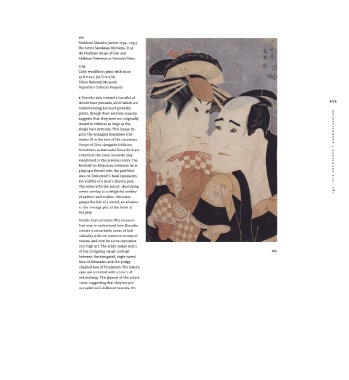Page 456 - Edo: Art in Japan, 1615–1868
P. 456
26o
Tóshüsai Sharaku (active 1794-1795)
The Actors Sanofeawa íchimatsu III as
the Prostitute Onayo of Gion and
Ichikawa Tomiemon as Kanisaka Toma
1794
Color woodblock print with mica
7
5
37.8 x 24.5 (i4 /s x 9 /s)
Tokyo National Museum
Important Cultural Property
• Sharaku also created a handful of
double bust portraits, all of which are 455
ranked among his most powerful
prints, though their extreme scarcity
suggests that they were not originally
issued in editions as large as the
single bust portraits. This image de-
picts the onnagata Sanokawa Ichi-
matsu III in the role of the courtesan
Onayo of Gion alongside Ichikawa
Tomiemon as KanisakaTóma. Both are
roles from the same vendetta play
mentioned in the previous entry. The
kerchief on Ichimatsu indicates he is
playing a female role; the pale blue
area on Tomiemon's head represents
the stubble of a man's shaven pate.
The robes with the actors' identifying
crests overlap in a delightful medley
of pattern and outline. Ichimatsu
grasps the hilt of a sword, an allusion
to the revenge plot at the heart of
the play.
Double bust portraits offer an excel-
lent way to understand how Sharaku
creates a remarkable sense of indi-
viduality with the utmost economy of
means, and how he turns caricature
into high art. The artist makes much
of the intriguing visual contrast 260
between the elongated, eagle-nosed
face of Ichimatsu and the pudgy-
cheeked face of Tomiemon. The latter's
eyes are accented with a touch of
red makeup. The glances of the actors
cross, suggesting that they are pre-
occupied with different worries. JTC

